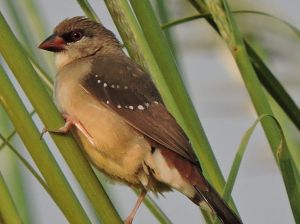If you like your finches small and brightly coloured, friendly and interesting to watch, then the Strawberry finch will be a great one to consider. These small three or four inch long finches are members of the same family as the equally tiny Gold Breast Waxbill and make great cage or aviary birds. Just beware that outside breeding condition the male hides – but he dresses up well when breeding time comes!
Meet the Strawberry finch
Technically, the Strawberry finch is called the Red avadavat (Amandava amandava) but it is easy to see where it’s common name came from. In breeding condition, the male bird has a brilliant red head, chest and rump with dark brown and black wings, back and tail feathers, all spotted with white. The female bird is duller with less white spots and outside the breeding season, the male changes his feathers to look much like her. Despite their small size, they have been known to live from 8 to 17 years in captivity.


Keeping in captivity
Generally, strawberry finches are said to be friendly and live happily with other finches. There can sometimes be aggression towards other birds of a similar colour when the male is in breeding condition. It is recommended to keep in a pair or in three pairs and avoid odd numbers of birds who may get picked on. They can hybridise with the Gold breast waxbill.
Their diet consists of a good foreign finch seed mixture along with fresh greens and access to fruit. They will also take egg food and sprouted seed. Insects such as fruit flies, mealworms and even termites can be offered especially during breeding season.
Due to their natural warm climate, these birds do need protection from the colder periods of the year. They sometimes need help to maintain their nails which are normally worn down by grasping grass stems but can become overgrown in captivity.
Breeding
In the wild, these birds breed over summer in their respective areas so will normally breed during the British summer. Live food should be introduced around a month before breeding begins to stimulate them once the male begins to change colour. They can breed in cages as well as in aviaries, well planted ones with plenty of light.
The male will display to the female while carrying a feather or a piece of grass, singing and bowing to her before mating. The pair will make a nest in an oval bamboo nest, a half-open finch nest or even build their own in bushes. They will use coconut fibre and line with feathers while pieces of grass will often cover the front of the nest.

